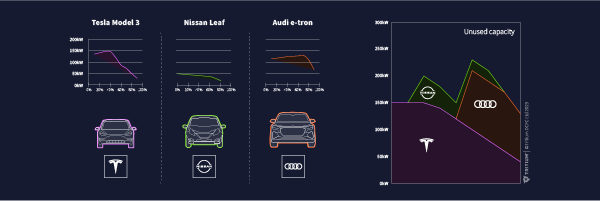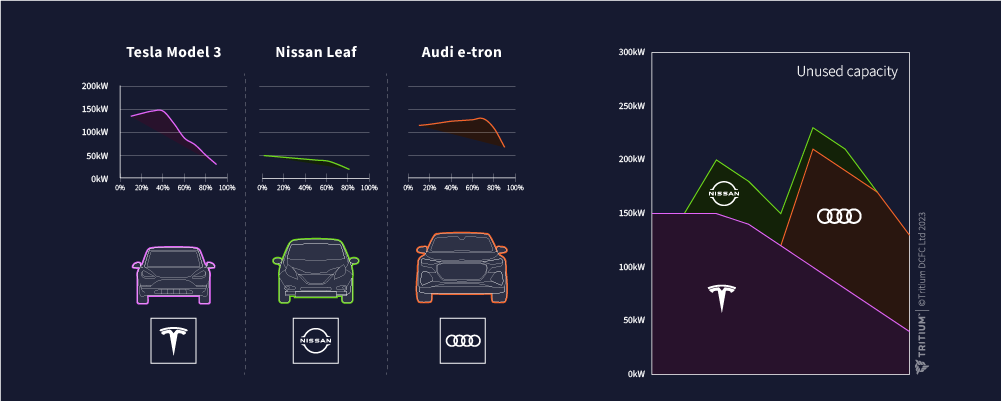Load balancing is more than just an efficient way to distribute power to charging EVs. It can enable charge point operators (CPOs) to use less-than-optimal power feeds by maximizing available power capacity, save on electricity costs, and help them charge more vehicles overall. Here’s how.
Tritium chargers use advanced load balancing algorithms to dynamically and efficiently distribute power among EVs in a charging hub. Load balancing provides the right amount of power to EVs at the right time. EVs don’t all charge at the same rate, and they don’t charge at the same rate over time from 0% to 100% battery capacity. EVs typically draw maximum power early in charging when they have a low state of charge to preserve battery health. Load balancing algorithms provide only the power each EV needs, leaving the rest of the available grid power to charge other EVs in the hub. To learn more, read our article about load balancing here.

Load balancing lets CPOs take advantage of less-than-optimal power feeds. Grid power is limited at many proposed charging sites, requiring CPOs to work with local utilities to upgrade site power to meet the needs of DC fast chargers. Load balancing lets CPOs build fast charging sites where grid power may not meet the full demands of all the chargers at the site.
For example, four 150kW chargers can draw a maximum of 600kW, which would require 600kW of site grid power. But thanks to charging curves and load balancing, four 150kW DC fast chargers will almost never draw a full 600kW simultaneously. A CPO can effectively install four 150kW chargers at a site that has 400kW of available power. One or two EVs at the site can utilize 150kW power for ultrafast charging while the other cars with a higher state of charge can utilize less power later in their charging sessions. This is known as “site oversubscription,” because the site initially contains more chargers than the power grid can support.
That means load balancing allows CPOs to install charging stations at more locations regardless of available grid power on site. As EV charging demands increase, CPOs can upgrade site power to match them over time.
The Tritium PKM system has a unique direct current (DC) grid that distributes power from the power cabinet (AC to DC rectification) to the chargers. DC cabling is light gauge and is about 30% of the cost of comparable alternating current (AC) cabling. The PKM DC grid also has less energy loss due to resistance than a comparable AC grid system. Overall, the PKM system is more than 99% efficient in converting AC grid power to DC. That means more of the power you pay for is delivered to charging EVs with minimal power loss.
Tritium’s unique granular 1kW load balancing system provides more available power for charging other EVs in the hub. When an EV requests 70kW of power, Tritium’s load balancing system can allocate exactly 70kW. In contrast, some other load balancing systems allocate power in larger 25kW increments. In this case, when an EV requests 70kW, the load balancing system allocates 75kW, leaving 5kW of power capacity unused.
When compared to other systems, Tritium’s built-in load balancing system makes more efficient use of available grid power. Because it can more effectively allocate power in granular increments of 1kW to charging EVs, the Tritium load balancing system can charge multiple EVs in less time than comparable systems.
Efficient charging is profitable charging. Tritium’s built-in load balancing system enables CPOs to achieve profitability quickly by reducing capital costs, facilitating a diverse range of charging locations, increasing overall efficiency, and charging more EVs faster.
To learn more about how Tritium charging systems with advanced load balancing can help CPO’s reach profitability faster, contact one of our experts today.
Electric vehicles (EVs) don’t all charge at the same rate. Some charge faster than others, and all of them charge at different rates over time. Even the fastest-charging passenger vehicles like the Audi e-tron GT do not draw their rated 270kW the entire time they’re plugged in to a DC fast charger. (Note: Large commercial vehicles like delivery trucks and buses can draw full power for most of the charging cycle.) That means you don’t need to deliver maximum power to every charger on your site at the same time. The chargers on your site can be networked and use load balancing to ensure EVs get the power they need when they need it—and you won’t have to outfit your charging site with gigawatts of power.
Charging a lithium-ion battery takes finesse—charge them too quickly or too much and they could overheat and become damaged. To prevent this, EVs use software to control the power delivery to the battery. Initially they can accept high levels of power, but as the battery charges up, charging levels drop to maintain battery health. Load balancing takes advantage of this difference in charging rates over time to deliver the right amount of power to EVs when it’s needed.

Load balancing lets you build a charging site now that meets the needs of EV drivers and your budget. You can build a site with multiple high-output DC fast chargers without the need to supply it with enough power to run all chargers at maximum power at the same time. This is crucial: You’ll save on utility-side infrastructure costs and you can upgrade site power when needed. This also expands the number of potential sites for your charging stations. Some sites may not have enough utility power now but will in the future. Load balancing lets you build a site now with a full complement of DC fast chargers and add more power capacity over time to meet future EV demands.
Tritium PKM150 chargers leverage the diversity of electric vehicle charging speeds via an innovative DC microgrid architecture and a proprietary algorithm to send the right amount of power to each charging station as required. The algorithm monitors various parameters, including available grid power, each vehicle’s requested power, and any active OCPP smart charging profiles, and dynamically shares power between all connected charging stations. Thanks to this load-balancing software and system design, four PKM150 chargers can share power from a single rectifier unit without the need for external load management solutions. This saves infrastructure and installation costs at the site.